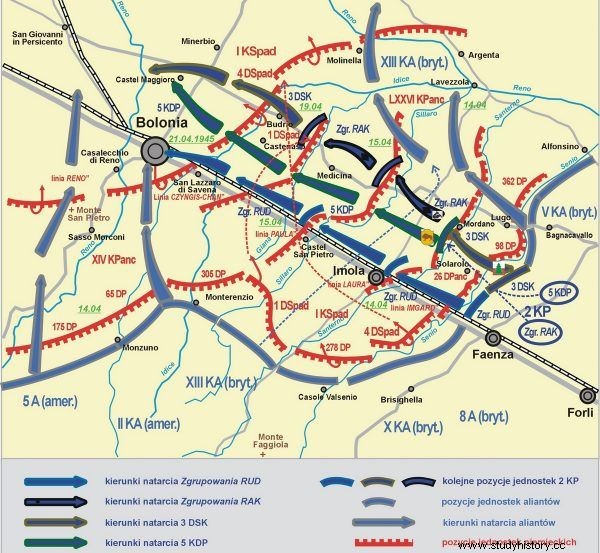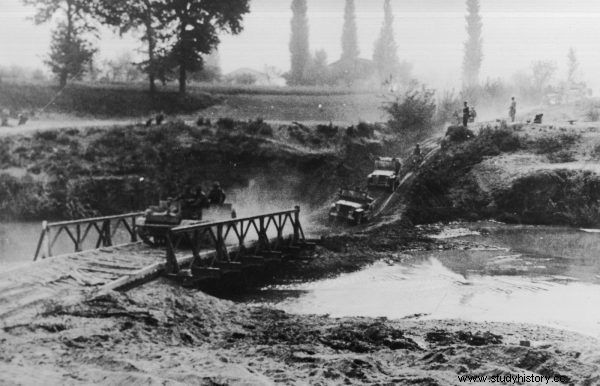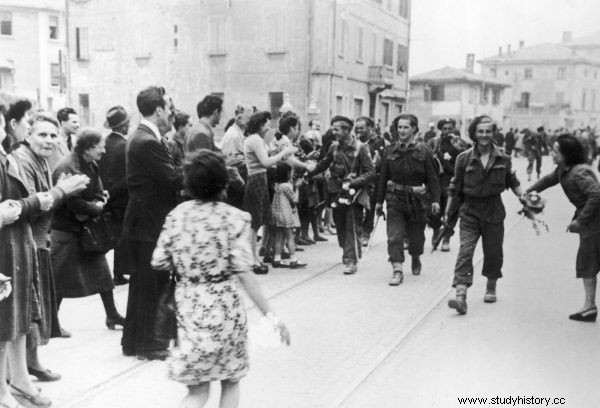The fate of Poland has already been sealed. Our soldiers, however, did not intend to lay down their weapons. In the last days of the war, they inflicted a severe defeat on the Germans. And it was they who entered as liberators into one of the most important cities of Italy.
The Battle of Monte Cassino was not the end of the Polish 2nd Corps' combat route in Italy. General Anders' soldiers fought the Germans along the coast of the Adriatic Sea for the next months. In the spring of 1945, the corps, already commanded by General Zygmunt Szyszko-Bohusz, took part in the offensive of the allied forces, which ended with the capture of Bologna by the Poles, which was decisive for the defeat of the Germans on the Italian front.
The Last Stand
The strike of the Allied Army Group 15, led by American General Mark Clark, was scheduled for April 9, 1945. The opponent of the Allied soldiers was the German Army Group "C" of General Heinrich von Vietinghoff, numbering 18 divisions. The Germans took advantage of the winter stagnation at the front by preparing a series of fortified positions based on the lines of successive rivers and defending access towards Bologna. The field fortifications were supplemented with artificial inundations. The bridges over the rivers have been partially destroyed and partially mined. The German defense zone was 40 kilometers deep.
The 2nd Polish Corps of the British 8th Army was tasked with breaking through the enemy positions on the Senio River and gaining bridgeheads on the Santerno River, which was to be the basis for pursuit actions against Germany. For the duration of the operation, the Poles were reinforced with British units:the motorized 43 Gurkha Brigade, the 7th Armored Brigade, part of the 25th Armored Sapper Brigade, equipped with, inter alia, into bridge tanks and flamethrowers.
In addition, the forces put under the Polish command included a battalion from the 14th Hussars Regiment, armed with "Sherman" tanks and Kangaroo armored personnel carriers, and equipped with armored cars, the 27th Lancers Regiment. Additional support for Polish soldiers were four regiments of British artillery. Apart from land units, the Polish air force also took an active part in the offensive.

Blueprint for the Battle of Bologna.
The offensive has started
In the zone of operations of the 3rd Carpathian Rifle Division, the operation began on April 9, 1945 at 1:30 p.m. with a massive bombing of enemy positions by the Allied air force. Unfortunately, one of the bomber groups confused the designated area and the bombs fell on the Carpathians who were preparing to fight. 37 Polish soldiers were killed and 199 wounded. Nevertheless, the Polish attack started at 7:30 pm.
At night, the soldiers of the Carpathian Division, breaking the strong resistance of the German 26th Panzer Division, crossed the Senio River and captured both flood embankments. They then continued their advance towards the Santerno River. The Germans fiercely defended themselves, skillfully using the support of their own artillery and mortars. Nevertheless, by the evening of April 11, the eastern embankment on the Santerno River was in Polish hands, and a bridgehead on the other bank was also captured.
For the next day, fierce battles were fought between the Poles and the Germans over this bridgehead. The enemy even launched a violent counterattack of tanks and armored guns to the positions of the 1st Carpathian Rifle Brigade. However, the situation was brought under control thanks to the lightning reaction of the Allied assault aviation and artillery, and the Germans were rejected. Thanks to the use of self-propelled bridges and finding a ford, it was possible to move tanks and other equipment to the other side of the river, which allowed for the capture of the western embankment.
 . It is the perfect gift for any history buff. "Width =" 600 ″ height ="435 ″ /> You can read about the victories of our weapons in our latest book " Polish triumphs " . It is the perfect gift for any history buff. The attack was preceded by an artillery barrage and three raids by bombing fighters. While the 5th KDP was forcing the river under heavy enemy fire, the "Rud" group, advancing along the road No. 9 leading to Bologna, was drawing fire from enemy cannons and mortars.
. It is the perfect gift for any history buff. "Width =" 600 ″ height ="435 ″ /> You can read about the victories of our weapons in our latest book " Polish triumphs " . It is the perfect gift for any history buff. The attack was preceded by an artillery barrage and three raids by bombing fighters. While the 5th KDP was forcing the river under heavy enemy fire, the "Rud" group, advancing along the road No. 9 leading to Bologna, was drawing fire from enemy cannons and mortars. Eventually, the battle flared up across the assault lane of the 2nd Corps. Polish soldiers fiercely tried to gain a foothold. The Germans did not manage to destroy the bridges over the river everywhere. One of them was captured by Polish commandos and tanks of the 4th Armored Regiment.
In pursuit of the enemy
In this exhausting struggle, the Poles finally pushed the Germans, whose remnants retreated to the Idice River. Having reached Gaiana, the 2nd Polish Corps found itself on the wing of the German troops fighting south of Bologna with the US 5th Army. At the same time, the British 5th Corps, located on the right wing of the Allied forces, reached the area of Argenta. At that time, the Americans broke through the German defenses and there was a chance to encircle enemy units near Bologna. The German command, seeing this, ordered the evacuation of their garrison from the city on the night of April 20-21.
The leading Polish troops captured bridgeheads on Idice, which created excellent conditions for further pursuit of escaping enemy units. Soon an order was issued to undertake this form of action on the entire section of the Polish front. The 3rd Carpathian Rifle Brigade from the "Rud" group was to capture the eastern edge of Bologna. It was not easy, because the road number 9, on which the unit was to advance, was under fire from the American artillery and it was necessary to intervene in this matter with the command of the 15th Army Group.

Soldiers of the 2nd Polish Corps cross the Idice River on the Bailey Bridge. Photo and caption from the book "Polish triumphs".
Eventually, two Polish companies crossed the Savena River and reached the eastern and northeastern suburbs of Bologna. The 9th Carpathian Rifle Battalion was approaching along the road number 9, while the 8th Battalion was heading towards the railway loop in the northern part of the city. In the evening of April 20, the commander of the "Rud" group, General Klemens Rudnicki, reached his brigade, who noticed that the Germans were retreating. So he ordered the brigade to take vigorous action and enter the city center on the necks of the escaping enemy. The general also wanted to seize the city ahead of the Americans.
The final of the fights
The units of the 9th Carpathian Rifle Battalion were the first to enter Bologna. It was six in the morning on April 21, 1945. Two hours later, American tanks entered the city, the commander of which expressed surprise that the city had already been captured. Poles were greeted with ovation and feted by the inhabitants of Bologna. The fighting historian in Italy, Zbigniew Wawer, described the mood of the moment as follows:
In front of the town hall the 3rd and 4th [of] 9th Battalion companies were standing in even lines, the faces of the soldiers were laughing, their red eyes radiated joy. Everyone congratulated them and probably everyone had an idea and regretted their fate that they had won the gratitude of Bologna welcoming them, and not Krakow, Cieszyn or Sącz. If only flowers from Polish meadows fell on them, thrown by the hands of Polish children and Polish girls! However, fate decreed otherwise.
As a result of the 12-day operation, the Germans lost approximately 32,000 killed and wounded soldiers. About 35,000 went into captivity. The 2nd Polish Corps eliminated nearly eight thousand enemy soldiers from the fight. However, the losses he suffered were also serious. 234 Polish soldiers were killed and 1,228 wounded.

Polish troops enter Bologna. The local population welcomes the soldiers of the 5th Kresowa Infantry Division. Photo and caption from the book "Polish triumphs".
It was the last battle of Anders' soldiers. On April 22, the Polish corps joined the reserve of the 8th Army. The next day its commander, General Richard McCreery sent a special, solemn order to the Poles, in which he wrote:"You played a decisive role in this great victory."
Less than a week later, on April 29, 1945 in Caserta, representatives of General von Vietinghoff signed the act of unconditional surrender of all German troops in Italy.
***
You can read about the successes of our weapon in the book “Polish triumphs. 50 glorious battles in our history ” . Learn about the clashes that changed the course of history with this richly illustrated publication. From victorious fights in the times of Bolesław the Brave, to fierce battles in World War II. Successes that every Pole should remember. Buy today with a discount at empik.com ,
Find out more:
- Biegański W., Bologna 1945 , MON Publishing House, Warsaw 1986.
- Mitcham S.W. jr, German Armed Forces 1939–1945. Rifle and light divisions. Ordre de Bataille , Bellona, Warsaw 2010.
- Mitcham S.W. jr, German Armed Forces 1939–1945. Armor. Ordre de Bataille , Bellona, Warsaw 2010.
- Nycz W. , In an aerial recon , MON Publishing House, Warsaw 1982.
- Śledziński K., The Accursed Army. The Odyssey of Anders' soldiers , Znak Horyzont, Krakow 2017.
- Tym J.S., Armored Forces of the Polish Armed Forces in the West 1940-1947 , Oficyna Wydawnicza Rytm, Warsaw 2012.
- Tymieniecki B., Her name was Lily , MON Publishing House, Warsaw 1984.
- Wawer, Direction to Bologna! The last battle of the 2nd Polish Corps , "Poligon", No. 3 (2015).
- Zajączkowski M., Commando Dagger , Bellona, Warsaw 1991.
